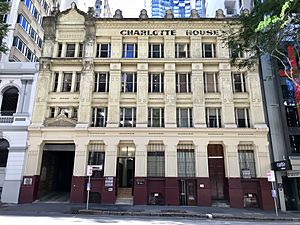Charlotte House facts for kids
Quick facts for kids Charlotte House |
|
|---|---|

Charlotte House, Brisbane, 2018
|
|
| Location | 139–145 Charlotte Street, Brisbane CBD, City of Brisbane, Queensland, Australia |
| Design period | 1870s – 1890s (late 19th century) |
| Built | 1888–1889 |
| Architect | John Joseph Lough |
| Official name: Charlotte House | |
| Type | state heritage (built) |
| Designated | 21 October 1992 |
| Reference no. | 600082 |
| Significant period | 1888–1889 (fabric) |
| Significant components | carriage/wagon/dray entrance, store/s / storeroom / storehouse, warehouse |
| Builders | James Baker |
| Lua error in Module:Location_map at line 420: attempt to index field 'wikibase' (a nil value). | |
Charlotte House is an old building in Brisbane, Queensland, Australia. It is located on Charlotte Street in the city center. This building was once a warehouse, a place for storing goods. It was designed by John Joseph Lough and built between 1888 and 1889 by James Baker. Charlotte House is considered important because of its history and design. It was added to the Queensland Heritage Register in 1992.
Contents
The Story of Charlotte House
Building a New Warehouse
Charlotte House is a four-story building that was built between 1888 and 1889. It was made for a company called Wallace Warren & Co. They were merchants, which means they bought and sold goods. They also imported items from other countries.
The building was designed by an architect named John Joseph Lough. He used interesting Greek and Egyptian styles in his design. This was a bit unusual for buildings at that time.
A Busy Area for Business
When Charlotte House was built, the area around Charlotte Street was becoming a busy place. Many other warehouses and factories were built there. This part of Brisbane was once known as "Frog's Hollow." By the late 1880s, it was a hub for storing and moving goods.
Who Used the Building?
Wallace Warren & Co. used Charlotte House for their business from 1889 to 1894. After that, a bank called the Commercial Banking Company of Sydney took over the building. They rented it out to different companies.
For example, the Crescent Packing Co. used it to process coffee and spices. Joyce Brothers, who made boxes, also had space there. A printer named Cecil Edgar Babbidge used it too.
From 1911 to 1919, a famous tea company called Inglis Ltd. used part of the building. They were known for their "Billy Tea" brand. Their large sign covered the entire side wall of the building.
Later, from 1912 to 1963, the building was owned by hardware companies. First, it was Robertson Tait & Co., then Wilson Tait. They sold wholesale hardware, like tools and building supplies.
In 1963, a new owner, Charlotte House Pty Ltd, bought the building. They made many changes inside in 1964. Today, different businesses use the building for their offices.
What Charlotte House Looks Like
Charlotte House is a four-story building with a basement. It is made of timber, brick, and cement.
Unique Design Features
On one side of the building, there is a special entrance for carriages or wagons. This part of the building looks different from the rest.
Large, flat columns called pilasters separate the windows. Some of these pilasters are more decorated than others. They have fluted (grooved) designs or Greek patterns.
There are also two decorative bands, called string courses, that go across the building. One is above the ground floor, and another is above the second floor. The top band has small block shapes called dentils.
Decorative Details
You can see carved brackets at the ends of the building. The carriage entrance has a fancy triangular shape called a pediment above it. This pediment also has the year "1886" carved into it.
Above the upper windows, you can see the words "Charlotte House" painted. At the very top of the building, there are decorative elements called acroteria. These are placed above the pilasters and the pediment.
Behind the main building, there is a two-story brick storage building. This was built at the same time as Charlotte House.
Even though the inside of the building was changed in 1964, the main structure and the front of the building (the facade) still look much like they did originally. You can still see the original timber frame and floor supports inside.
Why Charlotte House is Important
Charlotte House is listed on the Queensland Heritage Register. This means it is a special building that is protected because of its history and design. It was added to the register on October 21, 1992.
A Glimpse into Brisbane's Past
Charlotte House is important because it shows how the "Frog's Hollow" area of Brisbane grew into a busy warehouse district. It helps us remember what this part of the city was like long ago.
Special Design and History
This building is also special because it is a good example of a late 19th-century warehouse. Its front (facade) is still mostly original. The unique Greek and Egyptian designs make it stand out.

